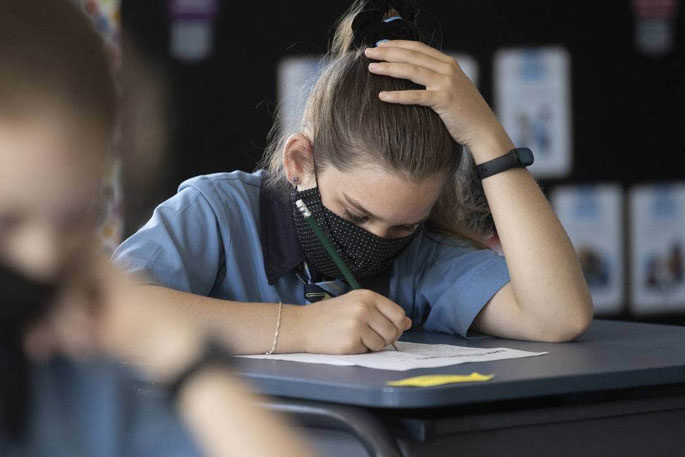Amid clear signs a second wave of Omicron has arrived, some schools have decided to make mask-wearing compulsory.
This is despite no Government mandate, in a bid to limit a worsening impact on learning.
A mandate for masks in schools was removed in mid-April, just before the end of the first school term.
The Government confirmed last week the country would stay at the Orange Covid-19 setting, but it encouraged the use of face masks indoors for year 4 students and above.
With about 100 students a day absent, Christchurch South Karamata Intermediate School this week re-introduced a 'circuit breaker” of mandatory mask wearing indoors.
An increase in student absences 'related to a range of winter illnesses” is affecting 'normal school operation”, principal Ross Hastings and board chairperson Mark Callaghan say in an email to parents.
'We feel the need to mitigate the situation to reduce disruption to learning and teaching.”
University of Canterbury professor and Covid-19 modeller Michael Plank says a steady increase in Covid-19 case numbers in the past week makes a second wave of Omicron 'likely” and will affect all parts of NZ.
'The signs are there that it does look likely that we're at the start of a wave.”
Case numbers could increase and peak at over 20,000 each day, just like the first Omicron wave in March.
On Sunday, the rolling average of case numbers was 6895. This compared with the previous Sunday, June 28, when the seven-day rolling average was 5480 – an increase of 26 per cent.
Plank says there's evidence from genome-sequencing data the more contagious Covid-19 variant of BA.5 is on the rise and will become dominant in the next few weeks.
The impact of a second wave will depend on how compliant people are with public health measures – the most important of which is still the Covid-19 vaccine, Plank says.
'It's still the best tool we have, so whether it's your first dose or your fourth dose it doesn't matter – now's a really good time to go out and get it.”
Mask-wearing and staying home when sick are also effective in limiting the spread of the virus, Plank says.
'I've seen some studies estimate as much as a 20 per cent reduction in spread as a result of mask wearing.”
The Government said last week it would supply each student in years 4 to 8 with 50 child-sized masks in term three, which starts on July 25.
Around 20,000 to 30,000 adult-sized masks are already being distributed to students and staff every week, says Associate Education Minister Jan Tinetti.
Principals' Federation president Cherie Taylor-Patel says there is wide variation in the approach schools are taking to mask-wearing.
Some schools have found it hard to maintain a strong culture of mask-wearing after the mandate was removed, she says.
'Over this year, it's been more difficult to maintain that ... when the peer pressure has gone on ... and it's left up to individuals to make a decision.”
Burnside High School principal and Canterbury West Coast Secondary Principals Association president Phil Holstein says the group wrote to the Minister of Education to express concern about the lack of consultation over the mask mandate decision.
'All of a sudden [the decision] was made for us, but we're the ones implementing that, and we would like to have had a voice in there.”
Burnside students were told they are 'expected” to wear a mask indoors, and Holstein is relieved students have complied.
Despite this, the school has moved back to a hybrid learning model after a spike in Covid-19 cases over the past couple of weeks.
The school has asked each year group to study at home one day a week to help manage absences related to illness, Holstein says.
He's concerned about the impact of the disruption on learning, particularly for senior students.
Beckenham Te Kura o Pūroto primary school principal and Canterbury Primary Principals' Association president Sandy Hastings says many schools, including her own, have seen a steep rise in illness among staff and students over the past 10 days.
'In a school of over 500 we have about 100 students away each day.”
Getting relief teachers is also becoming challenging for schools, with some forced to find cover for classes internally, Hastings says.
'I think the holidays are coming at a really good time, I think schools are really just trying to hold on until Friday.”
Hastings says her school has taken a 'cautious” approach and maintained a requirement for mask wearing indoors, but others have taken a more relaxed approach.
'When the mandate came off, some schools said, ‘mask wearing is now completely optional, we're not expecting you to [wear a mask]'.”



0 comments
Leave a Comment
You must be logged in to make a comment.